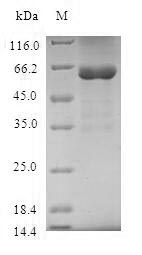The region for expressing recombinant Human STX11 contains amino acids 1-287. The expected molecular weight for the STX11 protein is calculated to be 60.2 kDa. This protein is generated in a e.coli-based system. The STX11 coding gene included the N-terminal GST tag, which simplifies the detection and purification processes of the recombinant STX11 protein in following stages of expression and purification.
Syntaxin-11 (STX11) is a member of the syntaxin family of proteins, which are involved in vesicle trafficking and membrane fusion events within cells. STX11 is specifically implicated in regulating the fusion of vesicles with lysosomes, playing a crucial role in the process of lysosomal exocytosis. This protein is predominantly expressed in hematopoietic cells, including NK cells and CTLs, where it is involved in the release of cytotoxic granules containing perforin and granzymes. The interaction between STX11 and Munc18-2, another protein involved in vesicle trafficking, is essential for proper vesicle fusion and cytotoxic granule release. Mutations in the STX11 gene are associated with familial hemophagocytic lymphohistiocytosis type 4 (FHL4), a rare and severe immune disorder characterized by uncontrolled activation of immune cells. Understanding the functions of STX11 is crucial for unraveling the molecular mechanisms underlying vesicle trafficking and immune responses in specific cell types.






